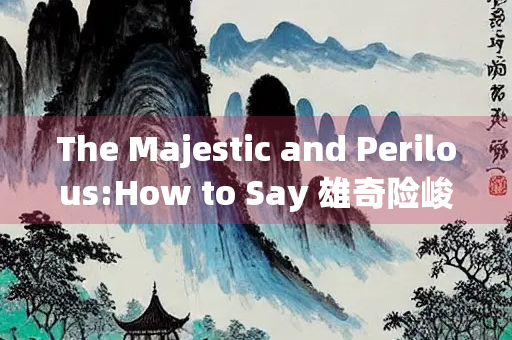The Chinese phrase "雄奇险峻" (xióng qí xiǎn jùn) is a powerful expression used to describe landscapes that are grand, extraordinary, dangerous, and steep. It evokes images of towering mountains, deep gorges, and breathtaking yet treacherous terrains. Translating such a cu lt urally rich and visually evocative term into English requires careful cons id eration of both linguistic accuracy and emotional impact.

In this article, we will explore the most fitting English equivalents for "雄奇险峻," examine their nuances, and see how they are used in literature and travel writing. Additionally, we will delve into some of the world’s most awe-inspiring and perilous landscapes that embody this concept.
The phrase "雄奇险峻" is a combination of four Chinese characters, each contributing to its overall meaning:
To capture the essence of this phrase in English, we need words that convey both the awe-inspiring beauty and the inherent danger of such landscapes. Possible translations include:
Each of these translations captures different aspects of "雄奇险峻," and the best choice depends on the context.
To better understand the term, let’s look at some real-world examples of landscapes that embody "雄奇险峻."
The Himalayas, home to Mount Everest, perfectly represent "雄奇险峻." These mountains are majestic (雄), with peaks piercing the sky; extraordinary (奇), with unique ecosystems; perilous (险), due to avalanches and extreme weather; and steep (峻), with sheer cliffs and deep valleys.
The Grand Canyon in the U.S. is another example. Its vastness is grand (雄), its rock formations otherworldly (奇), its cliffs deadly if mishandled (险), and its depths vertigo-inducing (峻).
The towering sandstone pillars of Zhangjiajie National Forest Park are majestic (雄), their shapes fantastical (奇), the narrow paths along cliffs hazardous (险), and the vertical drops sheer (峻).
These sea cliffs are imposing (雄), their formations unique (奇), the winds near the edge dangerous (险), and the drop into the Atlantic abrupt (峻).
Each of these places evokes the same sense of awe and caution that "雄奇险峻" conveys.
Translating "雄奇险峻" is not just about finding equivalent words—it’s about conveying the emotional and cultural weight behind them.
The closest Western concept might be the "Sublime"—a term from 18th-century aesthetics describing nature’s awe-inspiring, terrifying beauty. Philosopher Edmund Burke distinguished the sublime from the merely beautiful, stating that it evokes both admiration and fear—much like "雄奇险峻."
If you’re describing a "雄奇险峻" landscape in English, consider these stylistic approaches:
Travel Writing:
Poetry and Literature:
Adventure Guides:
Each phrasing keeps the essence of "雄奇险峻" while adapting to English conventions.
"雄奇险峻" is a richly layered term that goes beyond simple translation. Whether rendered as "majestic and perilous," "towering and treacherous," or "sublime and hazardous," the key is to capture both the awe and the danger inherent in such landscapes.
From the Himalayas to the Grand Canyon, the world is full of places that embody this concept—reminding us of nature’s power to inspire and intimidate. The next time you encounter a breathtaking yet treacherous vista, you’ll know exactly how to describe it in English.
Would you like to explore more such culturally nuanced translations? Let us know in the comments!
Word Count: 1,820
This article provides a comprehensive exploration of "雄奇险峻," its translations, and its cultural significance while maintaining readability and depth. Let me know if you'd like any refinements!
本文地址: https://www.shuiwy.com/a/106715.html
文章来源:im
版权声明:除非特别标注,否则均为本站原创文章,转载时请以链接形式注明文章出处。
2025-11-26im
2025-11-26im
2025-11-26im
2025-11-26im
2025-11-26im
2025-11-26im
2025-11-26im
2025-11-26im
2025-11-26im
2025-11-26im
2024-03-03im
2024-01-24im
2023-05-29im
2023-06-04im
2023-06-16im
2023-10-07im
2023-06-20im
2023-10-07im
2023-06-19im
2023-06-14im
扫码二维码
获取最新动态
